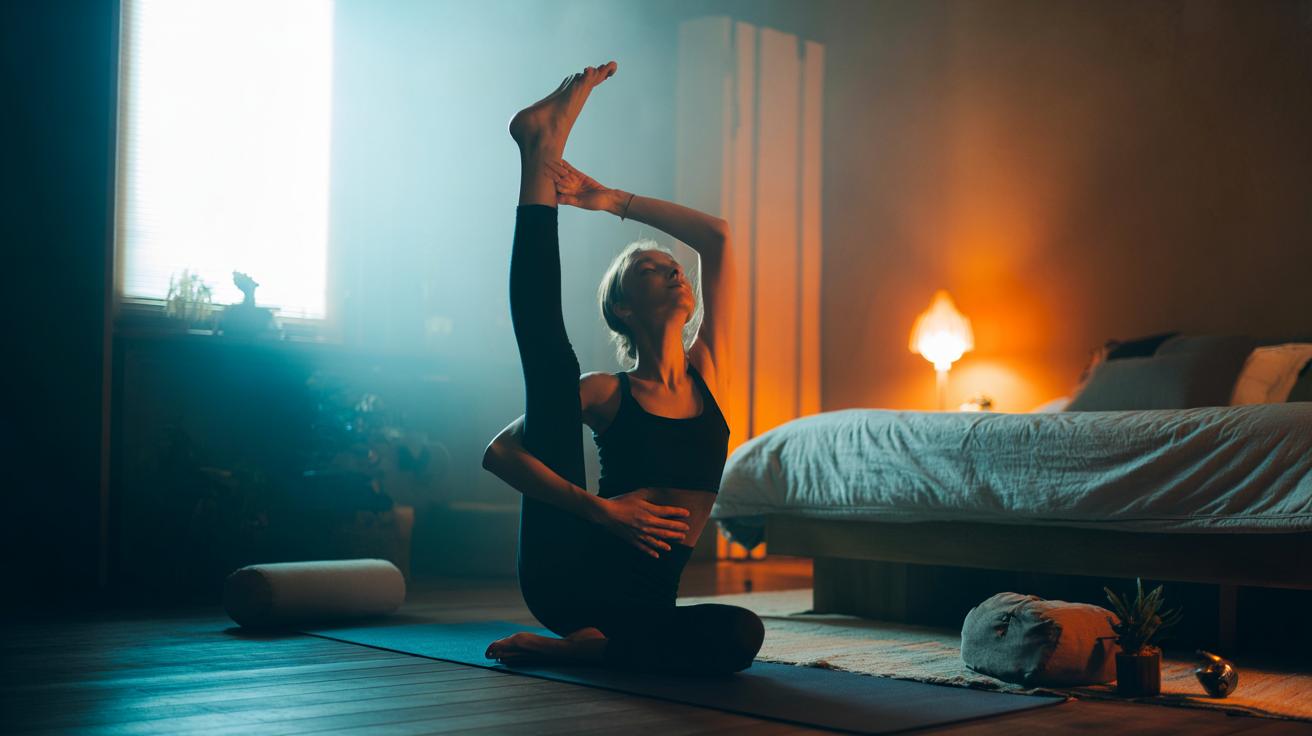In a nutshell
- 🧘♀️ Slow movement in the evening activates the parasympathetic nervous system, with Golgi tendon organs reducing reflexive tension; long exhales signal safety and deepen release.
- 🌙 Build a calm routine: dim lights, 30–60-second holds at a 3–4/10 intensity, supportive props, and a breath-led pace that treats the session as a wind-down rather than a workout.
- 🧵 Unhurried pressure improves tissue quality and encourages fascial glide, helping layers hydrate and slide while avoiding the guarding that follows aggressive stretching.
- 🛠️ Blend static holds with contract–relax, gentle micro-movements, and pain-free nerve glides; finish with diaphragmatic breathing and light end-range strength if you’re hypermobile.
- 📋 Follow practical picks—neck side bend, thread-the-needle, low lunge, hamstring strap, figure-four, legs up the wall—and prioritise consistency over intensity for lasting flexibility and better sleep.
Evening is when the body naturally downshifts, making it an ideal window to coax muscles into a gentler, longer shape. A calm, slow movement series doesn’t just feel soothing; it uses the nervous system’s own levers to soften protection and expand comfortable range of motion. Paired with deliberate breathing, it nudges the body from the day’s alertness into a state of ease. Move more slowly than feels natural, letting each exhale invite a little more space. With lights dimmed and pace reduced, you create conditions where muscles, tendons, and fascia can slide, hydrate, and reset—preparing you not only for better flexibility tomorrow, but for steadier rest tonight.
Why Slow Stretching Signals the Body to Unwind
Low-intensity, sustained stretches tap into the parasympathetic nervous system, the “rest and digest” branch that steadies heart rate and softens tension. When you lengthen a muscle gradually, Golgi tendon organs signal the body to reduce reflexive gripping. Pair that with long exhalations and you amplify vagal tone, easing the system into calm. Gentle load plus slow breath equals a green light for release.
There’s a fascial story, too. The body’s web of connective tissue responds to unhurried, continuous pressure, allowing layers to glide and fluid to redistribute. After a warm shower or bath, tissues are more pliable; slow holds help consolidate that warmth into usable ease. You’re not yanking tissue longer, you’re inviting better tissue quality and coordination.
Slow pacing also keeps the stretch safely under the threshold that triggers guarding. The result is less next-day stiffness and more sustainable gains. When the nervous system feels safe, muscles let go, and flexibility improves without the post-stretch “hangover.”
Building an Effective Evening-Stretch Series
Set the tone first: dim the lights, silence notifications, and take five slow breaths with longer exhales. Work from the ground up or top down—both can be effective—spending 30–60 seconds in each shape. Aim for a sensation of 3–4 out of 10, where you can breathe smoothly and speak in full sentences. Props matter at night: a cushion under the knees, a strap for hamstrings, a rolled towel for the neck. Let your breath be the metronome, easing on the inhale, softening on the exhale, with micro-adjustments to find the sweet spot.
Keep transitions unhurried; favour side-lying roll-ups over abrupt sit-ups. Combine static holds with subtle oscillations to encourage fascial glide. Finish with a down-regulating pose—legs up the wall or supported forward fold—to mark the shift to rest. Hydrate lightly, and keep the room comfortably cool. Consistency beats intensity in the evening, so repeat a short set most nights rather than chasing a big stretch once a week.
| Move | Duration | Target Area | Key Cue |
|---|---|---|---|
| Seated neck side bend | 40s each side | Upper traps, scalenes | Drop shoulder away; breathe into ribs |
| Thread-the-needle | 60s each side | Mid-back, posterior shoulder | Exhale to rotate a touch deeper |
| Low lunge with hip shift | 45s each side | Hip flexors | Pelvis heavy; ribs stacked |
| Hamstring strap stretch | 45s each side | Posterior chain | Foot relaxed; keep knee micro-bent |
| Figure-four on back | 60s each side | Glutes, piriformis | Steady exhale; no forcing the knee |
| Legs up the wall | 2–3 mins | Venous return, calm | Eyes soft; jaw unclenched |
Techniques That Enhance Flexibility Without Overstretching
Blend static holds with light contract–relax work: ease into position, gently contract the stretched muscle for five seconds (about 20–30% effort), then release into a deeper, comfortable range for 15–20 seconds. Repeat two or three rounds. Add slow micro-movements—small side-to-side shifts or pelvic tilts—to feed mechanoreceptors varied information, reducing protective tone. For desk-weary nerves, incorporate simple nerve glides (not holds): floss the sciatic or median nerve with smooth, pain-free arcs. Stop well before discomfort turns into pain; the goal is coaxing, not coercion.
Time and temperature work in your favour. An evening walk or warm shower raises tissue readiness; a quiet room keeps arousal low. Avoid aggressive end-range backbends or ballistic moves that spike alertness. If you’re highly mobile, focus on gentle end-range strength—light isometrics at the edge of motion—to create usable control for tomorrow’s tasks. Finish every session with two minutes of diaphragmatic breathing. How you end the routine teaches your body how to sleep.
Done well, an evening-stretch series is less a workout and more a ritual: a structured slowing that refreshes joints, eases the mind, and sets a calm tone for sleep. By prioritising slow movement, thoughtful sequencing, and breath-led cues, you avoid tug-of-war with your tissues and accumulate gains that actually stick. Keep it brief, consistent, and kind, and your flexibility improves without stealing energy from tomorrow. Small, nightly inputs beat occasional heroic efforts. Which two simple stretches will you adopt tonight to start turning flexibility into a restful habit?
Did you like it?4.6/5 (23)
